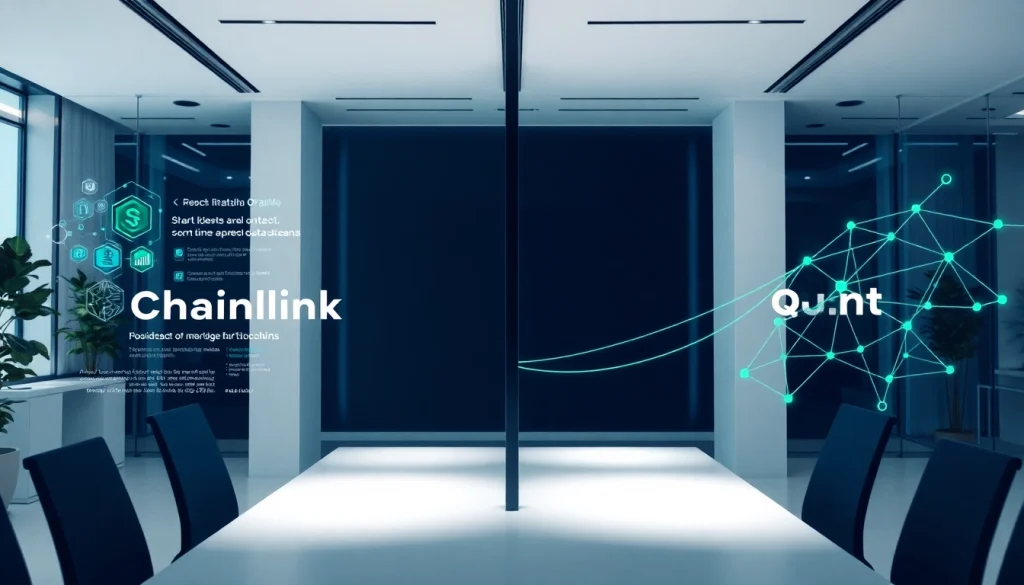
Introduction to chainlink vs quant
The blockchain landscape is evolving rapidly, and among the multitude of projects vying for attention, two notable players are Chainlink and Quant. While they both serve critical roles in the blockchain ecosystem, their approaches and functionalities differ significantly. This article aims to delved into a comparative analysis of these two platforms to understand their unique value propositions and how they can serve various applications in the broader blockchain world. We will explore chainlink vs quant in several dimensions: technical differences, use cases, market performance, and future outlook.
Understanding blockchain technology
Before diving into the specifics of Chainlink and Quant, it’s essential to understand the fundamental principles of blockchain technology. At its core, blockchain is a decentralized ledger that records transactions across many computers in a way that the registered information cannot be altered retroactively. This ensures transparency and security. Blockchain technology has numerous applications, from cryptocurrency to supply chain management, and the need for connectivity and data interoperability is becoming increasingly evident.
Overview of chainlink vs quant
Chainlink acts as a decentralized oracle network that facilitates smart contracts to securely connect with external data sources, APIs, and payment systems. This capability allows smart contracts to react to real-world events, significantly enhancing their utility. On the other hand, Quant provides Overledger technology, which aims to ensure interoperability between different blockchain systems. It allows data and value to flow seamlessly between disparate networks, addressing one of the most significant challenges in the blockchain ecosystem: connectivity.
Importance of choosing the right blockchain solution
Choosing the right blockchain solution is critical for developers and businesses alike. The right choice can lead to enhanced functionality, scalability, and long-term viability. As we explore Chainlink and Quant, it’s crucial to consider factors such as the specific requirements of the project, the potential for growth, and how these technologies align with future developments in the blockchain landscape.
Technical Differences between chainlink vs quant
How chainlink operates as a decentralized oracle
Chainlink provides a decentralized oracle network, which serves as a bridge between blockchain smart contracts and real-world data. The way Chainlink operates is through a network of nodes that independently verify the authenticity of data before it is provided to smart contracts. This decentralization adds a layer of security and trust that is critical for applications relying on accurate data. With Chainlink oracles, developers can use data from various sources, including APIs, and integrate it into their smart contracts seamlessly. This functionality makes Chainlink essential for the burgeoning field of decentralized finance (DeFi) and beyond.
The function of Quant’s Overledger technology
Quant’s Overledger technology operates differently, focusing on connectivity and interoperability between diverse blockchains. Traditional blockchain systems often operate in isolation; however, Overledger allows various blockchains to communicate with one another through a layer of abstraction. This essentially creates a “multi-chain” environment, where applications can leverage the strengths of multiple blockchains. By employing standardized APIs, Overledger enables developers to build and deploy applications that can access the features of different blockchains without getting bogged down by the idiosyncrasies of each individual network.
Comparing scalability and interoperability
When assessing the scalability of both technologies, Chainlink excels in integrating external data, which promotes the scaling of smart contracts by providing them with relevant information dynamically. However, its own infrastructure does rely on the existing blockchain’s scalability constraints. Conversely, Quant aims to bolster scalability through interoperability; it enables applications to draw upon resources from multiple chains, thereby enhancing performance and usability. Consequently, while Chainlink focuses on enriching individual smart contracts, Quant emphasizes broader connectivity across the blockchain ecosystem.
Use Cases for chainlink vs quant
Applications in finance and insurance
In the financial sector, Chainlink has emerged as a go-to solution for improving data accuracy in smart contracts used in DeFi applications. For example, oracle networks from Chainlink ensure that prices fetched from off-chain exchanges are reliably delivered to smart contracts, allowing for proper execution of trades and settlements. In contrast, Quant can be instrumental in insurance applications that require data from multiple blockchains. For instance, a cross-chain insurance product could aggregate data related to climate events from one blockchain and policyholder identity data from another, streamlining the claims process.
Impact on smart contracts and decentralized finance
The rising prominence of smart contracts and DeFi applications places both Chainlink and Quant in vital positions. Chainlink’s reliable oracles greatly enhance the functionality of smart contracts, allowing developers to implement complex automated agreements like decentralized exchanges and liquidity pools. Meanwhile, Quant fosters an environment where these smart contracts can interact across various platforms, which can facilitate greater innovation. The possibility of linking traditional financial systems with decentralized platforms through both technologies could redefine the industry’s landscape.
Real-world examples of implementation
Multiple real-world implementations underline the capabilities of both technologies. Chainlink has been utilized by numerous DeFi protocols to ensure accurate pricing feeds, such as in lending platforms where the collateral value is monitored through oracles. In contrast, Quant has established collaborations with governmental agencies and financial institutions, enhancing national and cross-border data flow. These real-world applications highlight the need for data reliability and interoperability in a rapidly evolving technology landscape.
Market Performance Analysis: chainlink vs quant
Price trends and market capitalization
Analyzing price trends is essential for understanding the potential investment value of both Chainlink and Quant. Historically, Chainlink’s market capitalization has remained robust due to its integral role in DeFi and growing partnerships. In contrast, Quant seeks to diversify its presence by promoting interoperability, which could garner attention from enterprises looking to adopt blockchain solutions across various functions. Monitoring fluctuations in their price trends can provide insights into market sentiment and adoption rates.
Trading volume and liquidity comparison
Trading volume is another critical metric in evaluating the performance of cryptocurrencies. Chainlink typically sees high trading volumes, indicative of its liquidity, making it a more favorable option for traders. Quant, while less liquid, is gaining traction as more use cases emerge, potentially driving its trading volume upwards as the demand increases. Understanding these dynamics can better inform investment strategies and expectations for each asset.
Potential growth and investment considerations
Investment considerations should be deeply rooted in understanding each project’s fundamentals and future prospects. For Chainlink, the ongoing demand for decentralized oracles suggests a positive growth trajectory as DeFi and other blockchain applications proliferate. For Quant, its multi-chain strategy offers a unique vantage point; as blockchain adoption rises, the need for interoperability will likely lead to increased investment interest in Overledger technology. Investors must weigh these factors carefully, considering long-term trends and individual risk appetite.
Future Outlook for chainlink vs quant
Trends in blockchain technology
The future of blockchain technology is poised for growth. Increasing demand for decentralized solutions, greater regulatory clarity, and the establishment of standards for interoperability signal an optimistic outlook. Both Chainlink and Quant stand to benefit from these broad trends, but their trajectories will differ. While Chainlink will continue to solidify its role in data provision, Quant’s future hinges on its ability to expand and streamline cross-chain communications.
Predictions for the next few years
Machine learning and artificial intelligence are expected to play significant roles in blockchain developments in the coming years. As both technologies evolve, we may see integrated solutions that enhance their functionalities. Chainlink may expand its suite of oracles to include more complex data types, while Quant could refine its APIs further to enable more straightforward access for developers. Observing these trends can help stakeholders make informed predictions on the evolving landscape of blockchain technology.
Strategic advantages in upcoming developments
Looking ahead, Chainlink’s recognizable brand in the DeFi space gives it a strategic advantage as new projects proliferate in that direction. Simultaneously, Quant’s focus on interoperability aligns well with the increasing demand for cross-chain solutions. Both projects are well-positioned to capture the attention of diverse industries evolving to meet the demands of the digital economy, making it essential for investors and developers to keep a close eye on their progress and innovations.






